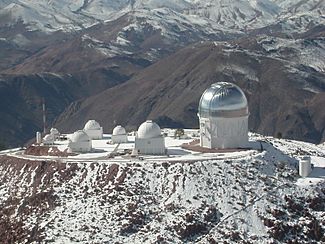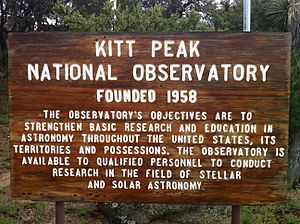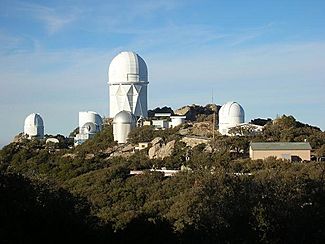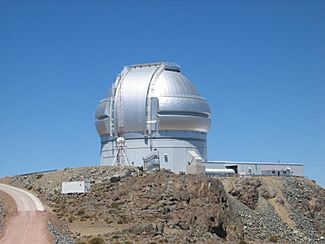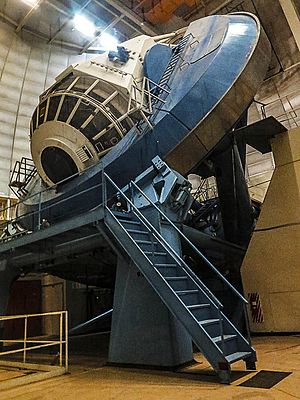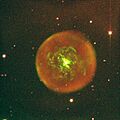National Optical Astronomy Observatory facts for kids
The National Optical Astronomy Observatory (NOAO) was a special place in the United States for studying the night sky. It focused on ground-based astronomy, using telescopes that looked at ultraviolet, visible light, and infrared light.
The National Science Foundation (NSF) helped fund NOAO. This allowed NOAO to provide amazing research tools for astronomers in the U.S. But here's a cool fact: astronomers from anywhere in the world could apply to use NOAO's telescopes! This was part of the NSF's "open skies" rule. Scientists would send in their ideas, and if they were good, they'd get time on the telescopes. These telescopes were busy almost every night of the year! This open access and fair process made NOAO very special.
NOAO was run by an organization called the Association of Universities for Research in Astronomy (AURA). Its main office was in Tucson, Arizona. NOAO was started in 1984. It brought together the Kitt Peak National Observatory in the U.S. and the Cerro Tololo Inter-American Observatory in Chile.
Later, on October 1, 2019, NOAO joined forces with the Gemini Observatory and the Vera C. Rubin Observatory. Together, they formed a new, bigger group called the National Optical-Infrared Astronomy Research Laboratory (NOIRLab).
Contents
Telescopes
NOAO used to operate world-class research telescopes in both the northern and southern parts of the world. These telescopes were at Kitt Peak in the U.S. and Cerro Tololo in Chile. Having telescopes in both places allowed astronomers to observe the entire sky. The instruments on these telescopes could see light from visible to near-infrared wavelengths. They used special cameras and spectrometers to study space.
Cerro Tololo Inter-American Observatory (CTIO)
CTIO has offices in La Serena, Chile, a town by the sea. The telescopes are located about 70 kilometers (43 miles) inland. They sit in the foothills of the Chilean Andes mountains. You reach the observatory by traveling through the beautiful Elqui Valley.
One important telescope at CTIO is the Victor M. Blanco Telescope. It was named after astronomer Victor Manuel Blanco in 1995. This telescope has a wide-field camera that uses a CCD (Charge-Coupled Device). It also has a special camera for near-infrared light and a spectrograph for visible light.
The Blanco 4-meter telescope was very important in discovering Dark Energy. Dark Energy is a mysterious part of the universe that is making it expand faster and faster. In 2012, the Blanco telescope got a new camera called the Dark Energy Camera, or DECam. This camera was built at Fermilab in the U.S.
DECam was made for the Dark Energy Survey. This project takes pictures of a huge part of the sky to very faint light levels. It helps scientists map out the large-scale structure of galaxies. By looking back in time, they hope to understand more about dark energy.
CTIO also helps run the 4.1-meter Southern Astrophysical Research Telescope (SOAR). SOAR focuses on making very clear, detailed observations. It will soon use a special system called adaptive optics to help with this.
Kitt Peak National Observatory (KPNO)
KPNO is located near Tucson, Arizona. The mountain, Kitt Peak, is on the land of the Tohono Oʼodham Native American people. The land has been leased from them since 1958. The native name for the mountain is "loligam," which means manzanita.
The observatory opened in 1958. Its biggest telescope, the Nicholas Mayall 4-meter, was dedicated in 1973. The Mayall telescope played a key role in finding evidence of dark matter. Observations of other galaxies showed they spun faster than they should if they only had the stars we could see. This suggested there was extra, invisible matter.
A new wide-field camera for near-infrared light, called NEWFIRM, has been used at KPNO. It helps scientists study how stars form in galaxies, learn about the universe's history, and understand how galaxies are built and change over time.
NOAO Gemini Science Center (NGSC)
NOAO also helped manage the U.S. part of the international Gemini Observatory. Gemini is a partnership between several countries: Argentina, Australia, Brazil, Canada, the United Kingdom, and the United States. The U.S. pays for half of the project, which is funded by the NSF. This gives U.S. astronomers access to Gemini's two 8-meter telescopes. One telescope is in Chile, near CTIO, and the other is in Hawaii.
Gemini is very important because it's the only facility available to all U.S. astronomers for studying large areas of the sky. "Large aperture" usually means telescopes between 6.5 and 10 meters wide. Gemini can take pictures and analyze light in near-infrared, mid-infrared, and visible light. It does this in both the northern and southern hemispheres.
One of Gemini's best features is its ability to take very sharp pictures using laser guide star adaptive optics. This technology helps correct for blurry effects caused by Earth's atmosphere. For example, Gemini astronomers, working with scientists at the 10-meter W. M. Keck Observatory, recently took the first pictures of an exoplanet system with three planets orbiting a star called HR 8799.
Large Synoptic Survey Telescope (LSST)
NOAO was a founding partner in the LSST project. The LSST is an 8-meter class telescope that will change how some astronomers do science. It's like a huge science experiment. LSST will collect its own data and provide it to the astronomy community. This data will include images and catalogs of astronomical objects.
The LSST will have a special wide-field camera. It will scan the entire sky visible from the southern hemisphere about once a week. By repeating these observations for ten years, LSST will create a very deep image of the sky. It will also find many objects that change in brightness daily or over longer periods. LSST scientists will then analyze this huge amount of data instead of going to the telescope themselves.
LSST is currently being built. NOAO is responsible for designing and developing the LSST telescope system and its facilities. LSST will be located on Cerro Pachón in Chile, close to the Gemini and SOAR telescopes. It will share its operations with Gemini, SOAR, and NOAO, both on the mountain and in La Serena.
A System of US Telescopes
At the start of the new millennium, the National Academy of Sciences published a report about astronomy for the next ten years. One of their main ideas was that U.S. ground-based optical and infrared telescopes should work together as one big system. This system would use money from both government and private sources. They said that national organizations were important to help coordinate these efforts. Universities and other observatories should also work with these national groups.
NOAO worked hard with the U.S. astronomy community to develop this "System." A great success was giving public access to large telescopes not funded by the government. This was done through a program called TSIP, funded by the NSF and managed by NOAO. With the help of private observatories, this program provided about 70 nights of observing time each year to the wider U.S. astronomy community.
The idea of this "System" was also supported by the NSF in 2007. NOAO continued to work to make sure the U.S. astronomy community had access to the best research tools. This ensures that science based on merit can continue to thrive.
A big future project for the U.S. system is an Extremely Large Telescope. These telescopes could be up to 30 meters (about 100 feet) wide! Two private groups are working on such projects, which might be ready before the end of the decade. These are the Thirty Meter Telescope and the Giant Magellan Telescope. NOAO is working with both projects. They are planning how the wider U.S. astronomy community might get involved in the future, possibly with funding from the NSF.
Images for kids


